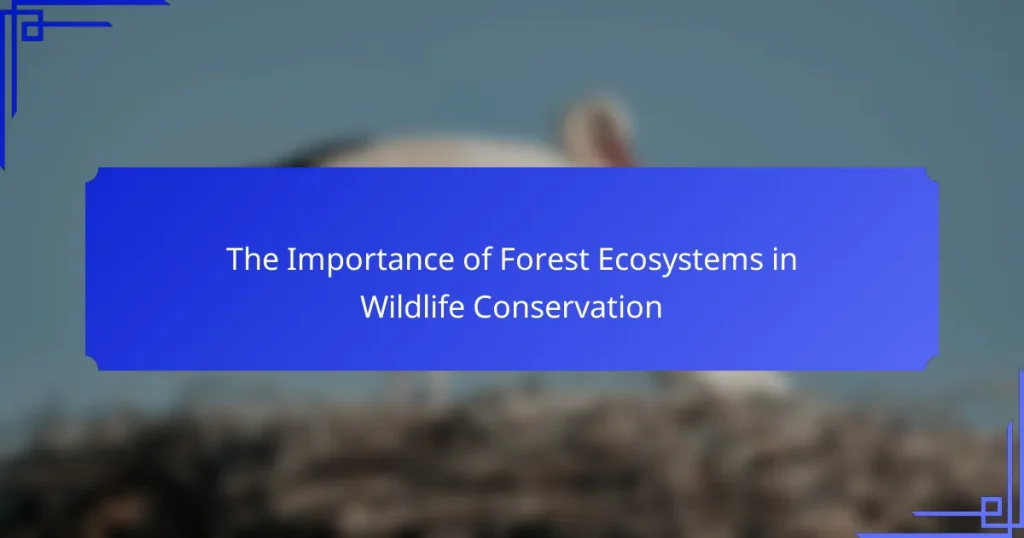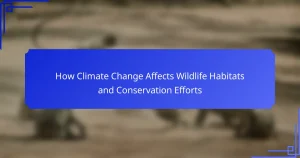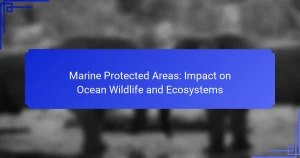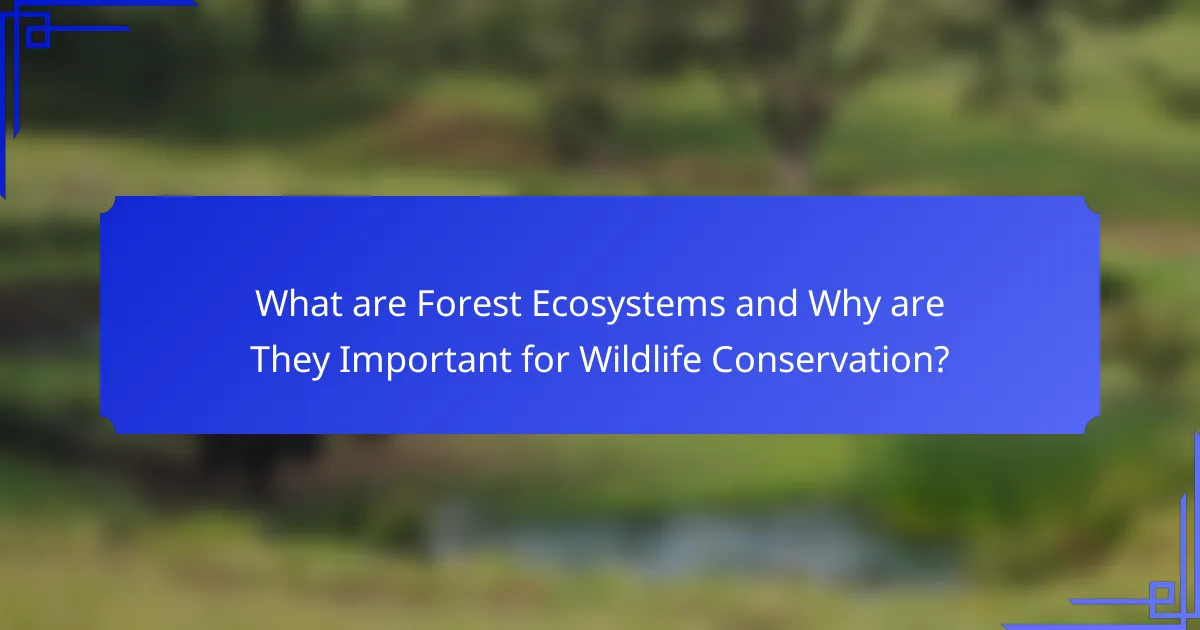
What are Forest Ecosystems and Why are They Important for Wildlife Conservation?
Forest ecosystems are complex communities of plants, animals, and microorganisms interacting with their physical environment. They cover about 31% of the Earth’s land area and provide crucial habitats for over 80% of terrestrial species. These ecosystems play a vital role in wildlife conservation by maintaining biodiversity. Healthy forests support various species, offering food, shelter, and breeding grounds. They also help regulate climate and water cycles, which are essential for the survival of many organisms. Deforestation and habitat loss threaten wildlife populations, making forest conservation critical. Studies show that protected forest areas significantly enhance species richness and abundance.
How do Forest Ecosystems Support Biodiversity?
Forest ecosystems support biodiversity by providing essential habitats for a wide variety of species. These ecosystems contain diverse plant and animal life, which contributes to ecological balance. Forests offer food, shelter, and breeding grounds for many organisms. They also maintain soil health and water cycles, which are crucial for sustaining life.
According to the Food and Agriculture Organization, forests are home to 80% of terrestrial biodiversity. This statistic highlights the critical role forests play in preserving various species. Additionally, forests facilitate genetic diversity by allowing different species to adapt to changing environments.
Overall, the complex interactions within forest ecosystems foster a rich tapestry of life, making them vital for biodiversity conservation.
What types of wildlife inhabit forest ecosystems?
Forest ecosystems are home to diverse wildlife. This includes mammals like deer, bears, and foxes. Birds such as owls, woodpeckers, and songbirds also inhabit these areas. Reptiles like snakes and lizards can be found in forest environments. Amphibians, including frogs and salamanders, thrive in moist forest conditions. Insects play a crucial role in these ecosystems, with species like butterflies and beetles being prevalent. Each of these wildlife types contributes to the ecological balance within forest ecosystems.
How do forest ecosystems provide habitat for endangered species?
Forest ecosystems provide habitat for endangered species by offering essential resources and shelter. These ecosystems support diverse flora and fauna, creating a rich environment. They provide food sources like fruits, leaves, and prey for various species. Dense vegetation offers protection from predators and harsh weather. Additionally, forest ecosystems maintain soil quality and water sources vital for survival. They also facilitate breeding and nesting opportunities for many endangered species. According to the World Wildlife Fund, forests are home to over 80% of terrestrial biodiversity, highlighting their critical role in conservation efforts.
What Role do Forest Ecosystems Play in Ecosystem Services?
Forest ecosystems are crucial providers of ecosystem services. They contribute to biodiversity, carbon storage, and water regulation. Forests support wildlife habitats and maintain ecological balance. They also play a vital role in soil formation and protection. According to the Food and Agriculture Organization, forests cover 31% of the world’s land area and store 80% of terrestrial biodiversity. Moreover, forests sequester approximately 1.1 billion tons of carbon dioxide annually. This demonstrates their significant impact on climate regulation and sustainability. Forest ecosystems are essential for human well-being and environmental health.
How do forest ecosystems contribute to air and water purification?
Forest ecosystems contribute to air and water purification through various natural processes. Trees absorb carbon dioxide and release oxygen, improving air quality. They also filter pollutants from the air, such as sulfur dioxide and nitrogen oxides. Additionally, forest soil acts as a natural filter for water. It traps sediments and pollutants, allowing cleaner water to enter groundwater systems. Forests also regulate water cycles, promoting rainfall and reducing runoff. This helps maintain water quality in nearby streams and rivers. Studies show that forests can reduce sedimentation in water bodies by up to 90%. Overall, forest ecosystems play a crucial role in maintaining clean air and water.
What is the significance of carbon sequestration in forest ecosystems?
Carbon sequestration in forest ecosystems is crucial for mitigating climate change. Forests act as carbon sinks, absorbing carbon dioxide from the atmosphere. This process helps reduce greenhouse gas concentrations. According to the Food and Agriculture Organization, forests store about 289 gigatonnes of carbon globally. Additionally, healthy forests enhance biodiversity, providing habitats for various wildlife species. They also improve soil quality and water retention. These benefits contribute to ecosystem resilience. Thus, carbon sequestration plays a vital role in both climate regulation and wildlife conservation.
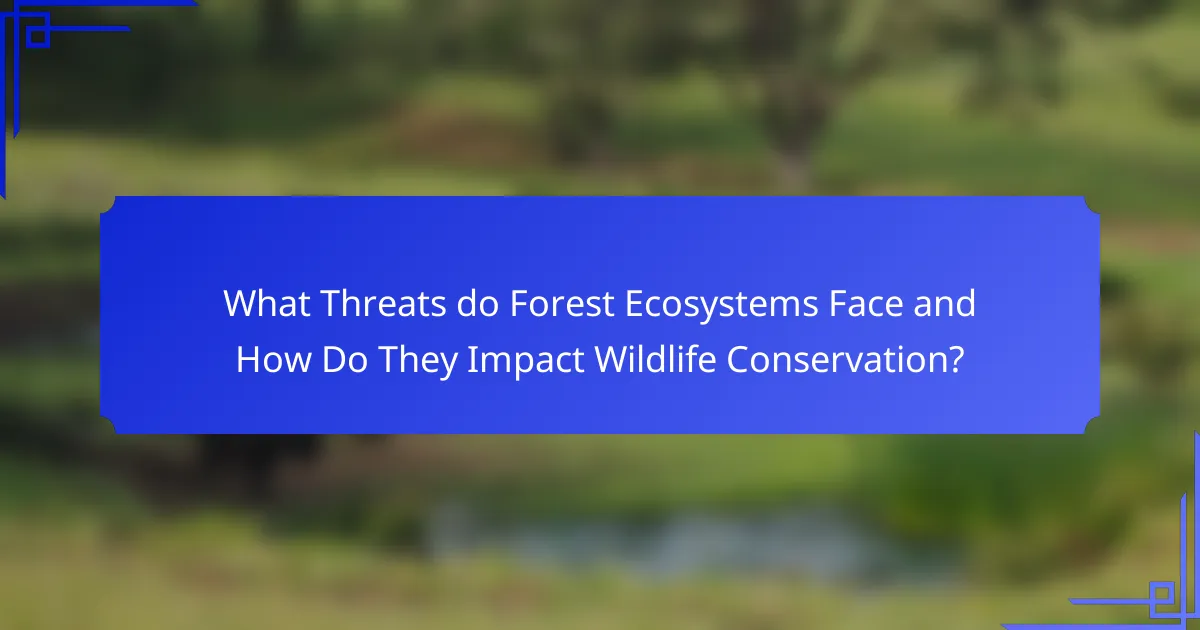
What Threats do Forest Ecosystems Face and How Do They Impact Wildlife Conservation?
Forest ecosystems face multiple threats, including deforestation, climate change, pollution, and invasive species. Deforestation leads to habitat loss, which directly impacts wildlife populations. Climate change alters temperature and precipitation patterns, affecting species survival and distribution. Pollution introduces harmful substances into the environment, harming plant and animal life. Invasive species disrupt local ecosystems, outcompeting native species for resources. These threats collectively hinder wildlife conservation efforts by reducing biodiversity and ecosystem resilience. According to the World Wildlife Fund, habitat destruction is a leading cause of species extinction globally.
What are the primary threats to forest ecosystems?
The primary threats to forest ecosystems include deforestation, climate change, invasive species, and pollution. Deforestation results from logging, agriculture, and urban development. It leads to habitat loss for countless species. Climate change affects temperature and precipitation patterns. This alters forest dynamics and species distributions. Invasive species disrupt local ecosystems by outcompeting native flora and fauna. Pollution from industrial activities contaminates soil and water, harming forest health. Each of these threats contributes to the decline of biodiversity in forest ecosystems.
How does deforestation affect wildlife populations?
Deforestation negatively impacts wildlife populations by destroying their natural habitats. When forests are cleared, animals lose their homes and food sources. This leads to decreased biodiversity as species struggle to survive. Many species become endangered or extinct due to habitat loss. For example, the World Wildlife Fund reports that deforestation contributes to the loss of 137 plant, animal, and insect species every day. Fragmentation of habitats also occurs, isolating animal populations and reducing genetic diversity. Additionally, deforestation increases human-wildlife conflict as animals encroach on human settlements seeking food. Overall, the loss of forests directly threatens the survival of countless wildlife species.
What impact does climate change have on forest ecosystems?
Climate change significantly impacts forest ecosystems. It alters temperature and precipitation patterns, affecting tree growth and species composition. Warmer temperatures can lead to increased pest outbreaks and diseases. Changes in rainfall patterns can cause droughts or flooding, stressing trees and other plants. These conditions disrupt the habitat for wildlife dependent on forests. According to the Intergovernmental Panel on Climate Change (IPCC), climate change threatens biodiversity and forest health. Forest ecosystems play a crucial role in carbon storage, and their degradation exacerbates climate change. Thus, the impact of climate change on forests has far-reaching consequences for wildlife conservation.
How can Conservation Efforts Protect Forest Ecosystems?
Conservation efforts can protect forest ecosystems through habitat preservation and restoration. These efforts maintain biodiversity by safeguarding native species and their habitats. Reforestation initiatives restore degraded areas, promoting ecological balance. Sustainable logging practices minimize damage to forests while allowing for resource extraction. Protected areas, such as national parks, provide safe havens for wildlife. Additionally, community engagement fosters local stewardship of forest resources. Research shows that well-managed conservation areas can increase species populations and enhance ecosystem resilience. For example, the World Wildlife Fund reports that protected forests help mitigate climate change impacts.
What strategies are effective in forest conservation?
Effective strategies in forest conservation include sustainable logging practices, reforestation, and protected area establishment. Sustainable logging minimizes environmental impact while allowing timber production. Reforestation involves planting trees to restore degraded areas, enhancing biodiversity. Establishing protected areas safeguards critical habitats from development and exploitation. According to the Food and Agriculture Organization, sustainable forest management can increase forest cover and biodiversity. Additionally, community engagement in conservation efforts leads to better resource management. Studies show that involving local populations in decision-making improves conservation outcomes.
How do protected areas contribute to wildlife conservation?
Protected areas play a crucial role in wildlife conservation by providing secure habitats for various species. These regions help to preserve biodiversity by protecting ecosystems from human activities. They serve as refuges for endangered and threatened species, allowing populations to recover. Protected areas also facilitate ecological processes, such as migration and breeding, essential for species survival. Research indicates that protected areas can significantly reduce the risk of extinction for many species. For instance, a study published in “Conservation Biology” found that protected areas helped increase populations of 75% of species studied. By maintaining healthy ecosystems, these areas support the overall resilience of wildlife.
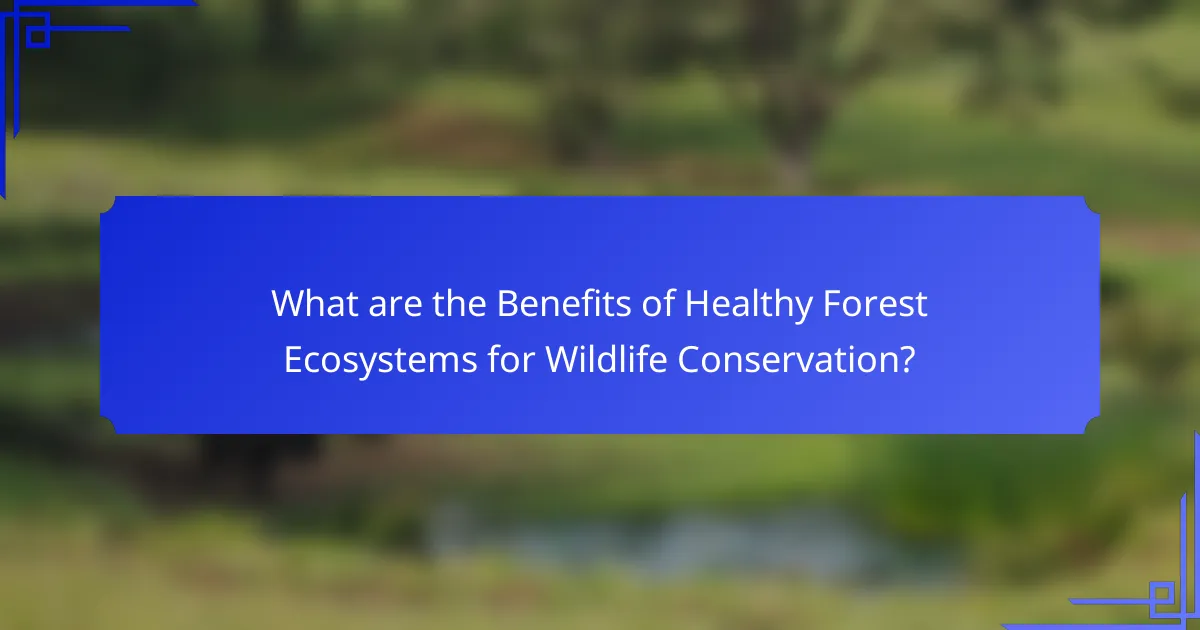
What are the Benefits of Healthy Forest Ecosystems for Wildlife Conservation?
Healthy forest ecosystems provide essential habitats for diverse wildlife species. These ecosystems support biodiversity by offering shelter, food, and breeding grounds. A study by the World Wildlife Fund indicates that forests are home to 80% of terrestrial species. Healthy forests also maintain ecological balance, which is critical for species survival. They help regulate climate, which impacts wildlife habitats. Additionally, forests filter water and improve soil quality, benefiting both flora and fauna. The presence of healthy forest ecosystems is linked to increased wildlife populations, as observed in various conservation areas.
How do healthy forest ecosystems enhance species survival?
Healthy forest ecosystems enhance species survival by providing essential habitats and resources. They offer shelter, food, and breeding grounds for diverse wildlife. Forests maintain biodiversity, which is crucial for ecosystem resilience. This biodiversity helps species adapt to environmental changes. Healthy forests also regulate climate and water cycles, supporting overall ecosystem health. Studies show that areas with intact forests have higher species richness. For instance, the World Wildlife Fund reports that healthy forests can support up to 80% of terrestrial biodiversity. Thus, intact forest ecosystems are vital for the survival of numerous species.
What role do forest ecosystems play in maintaining genetic diversity?
Forest ecosystems play a crucial role in maintaining genetic diversity among species. They provide a variety of habitats that support diverse plant and animal life. This diversity allows for a greater range of genetic variation within populations. Genetic variation is essential for adaptation to changing environmental conditions. Forests facilitate gene flow between populations through the movement of organisms. This movement helps to prevent inbreeding and promotes resilience against diseases. Additionally, forest ecosystems contribute to the preservation of rare and endemic species. Studies show that areas with rich forest biodiversity have higher genetic diversity. This highlights the importance of conserving forest ecosystems for the health of the planet’s biodiversity.
How do forest ecosystems support food chains and ecological balance?
Forest ecosystems support food chains and ecological balance by providing habitats and resources for diverse species. These ecosystems consist of various plants, animals, and microorganisms that interact in complex ways. Producers, such as trees and plants, convert sunlight into energy through photosynthesis. Herbivores then consume these plants, transferring energy up the food chain. Predators feed on herbivores, maintaining population control and species diversity.
Additionally, decomposers play a crucial role by breaking down organic matter, returning nutrients to the soil. This nutrient cycling supports plant growth and sustains the ecosystem. Forests also regulate water cycles and climate, contributing to overall ecological stability. Studies indicate that healthy forest ecosystems enhance biodiversity, which is essential for resilience against environmental changes. Thus, forest ecosystems are vital for sustaining food chains and maintaining ecological balance.
What Best Practices Can Enhance Forest Ecosystem Conservation?
Implementing sustainable forestry practices enhances forest ecosystem conservation. These practices include selective logging, which minimizes habitat disruption. Reforestation and afforestation restore tree cover and biodiversity. Establishing protected areas conserves critical habitats for wildlife. Community engagement fosters local stewardship of forest resources. Monitoring and research inform adaptive management strategies. These methods collectively support ecosystem resilience and health. Studies show that sustainable practices can increase biodiversity by up to 30%.
How can local communities engage in forest conservation efforts?
Local communities can engage in forest conservation efforts by participating in reforestation projects. These projects involve planting native trees to restore degraded areas. Community members can also organize clean-up events to remove litter from forest areas. Educating fellow residents about the importance of forests enhances awareness and support for conservation. Collaborating with local governments can lead to the establishment of protected areas. Communities can also monitor wildlife populations to assess ecosystem health. Utilizing sustainable practices in agriculture and forestry reduces environmental impact. Engaging in these activities helps preserve biodiversity and maintain ecosystem services.
What are some successful case studies in forest ecosystem conservation?
Successful case studies in forest ecosystem conservation include the restoration of the Atlantic Forest in Brazil. This project has led to the reforestation of over 2 million hectares. The initiative involved local communities in sustainable practices. It has resulted in increased biodiversity and improved ecosystem services.
Another notable case is the Yellowstone to Yukon Conservation Initiative in North America. This project aims to connect protected areas across a vast landscape. It promotes wildlife migration and habitat conservation. The initiative has successfully preserved critical habitats for species like grizzly bears and wolves.
The reforestation efforts in China’s Loess Plateau are also significant. This program has transformed degraded land into thriving forest ecosystems. It has improved soil quality and reduced desertification. The project has benefited local communities through enhanced agricultural productivity.
These case studies demonstrate effective strategies in forest ecosystem conservation. They highlight the importance of community involvement and sustainable practices.
Forest ecosystems are intricate communities of plants, animals, and microorganisms that are essential for wildlife conservation. Covering approximately 31% of the Earth’s land area, these ecosystems provide habitats for over 80% of terrestrial species, supporting biodiversity and ecological balance. The article examines the critical role of forest ecosystems in maintaining wildlife habitats, regulating climate, and offering ecosystem services such as air and water purification. It also addresses the threats facing these ecosystems, including deforestation and climate change, and highlights effective conservation strategies and successful case studies that demonstrate the importance of protecting forest ecosystems for the survival of diverse species.
